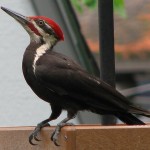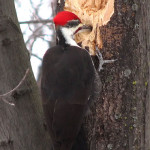Woody Woodpecker:
By Paul Stein
Have you ever hiked in the woods and heard a loud drumming resonating through the forest? Most likely you’ve been lucky enough to hear the elusive Pileated Woodpecker, the largest of the common woodpeckers in North America. These crow-sized birds present a memorable sight with their zebra-striped heads and necks, long bills, and distinctive red crests.
 Standing almost 18 inches tall with a wingspan of nearly thirty inches, the Pileated is easily distinguished from its smaller cousins—the Acorn and Downy Woodpeckers by its size; only the Ivory Billed Woodpecker, feared to be extinct in North America, is larger than the Pileated.
Standing almost 18 inches tall with a wingspan of nearly thirty inches, the Pileated is easily distinguished from its smaller cousins—the Acorn and Downy Woodpeckers by its size; only the Ivory Billed Woodpecker, feared to be extinct in North America, is larger than the Pileated.
Who doesn’t remember Woody the Woodpecker, the irreverent cartoon character? Woody was created in 1940 by Lantz and storyboard artist Ben “Bugs” Hardaway, who had previously laid the groundwork for two other screwball characters—Bugs Bunny and Daffy Duck—at the Warner Brothers cartoon studio in the late 1930s.
According to Lantz‘s press agent, the idea for Woody came during Lantz’s honeymoon with his wife, Gracie, in Sherwood Lake, California. A noisy Pileated Woodpecker outside their cabin kept the couple awake through the night, and when a heavy rain started, they learned from the numerous leaks that the pesky bird had bored holes in the cabin’s roof. Walter wanted to shoot the varmint, but Gracie insisted that he make a cartoon about the bird instead, and Woody was born. Who can forget Woody’s trademark laugh, “Ha-ha-ha-HAA-ha!” as only Mel Blanc (legendary voice of many cartoon characters) could deliver it?
While Woody may have made the Pileated famous, these birds are anything but common. While not considered endangered or possibly extinct like the Ivory Billed Woodpecker, it is most unusual to see one in the wild. They are very shy birds, seeking shelter when their habitat is invaded by intruders—be it the two-legged variety or other stealthy predators.
The Pileated forage for their favorite meal—carpenter ants—by boring large, rectangular holes in trees. This creates  the loud, hammering sound that echoes for great distances through the forest. The holes they create can be so large that they weaken smaller trees and can even cause them to break in half. Pileateds are so adept at boring holes that large wood chips can often be found beneath the tree cavity. Many other opportunistic birds take advantage of these large openings, accessing leftover exposed insects or using the holes as nesting sites.
the loud, hammering sound that echoes for great distances through the forest. The holes they create can be so large that they weaken smaller trees and can even cause them to break in half. Pileateds are so adept at boring holes that large wood chips can often be found beneath the tree cavity. Many other opportunistic birds take advantage of these large openings, accessing leftover exposed insects or using the holes as nesting sites.
Pileated Woodpeckers do not discriminate between coniferous and deciduous trees; as long as they yield the ants and beetle larvae that make up much of the birds’ diet. Woodpeckers sometimes access these morsels by peeling long strips of bark from the tree. They also forage on the ground and supplement their diet with fruits and nuts.
Woodpeckers also drum to attract mates and to announce the boundaries of their territories, staying close by throughout the year. They typically choose large, older trees for nesting and usually inhabit a tree hole.
The Pileated Woodpecker is a monogamous species and a mated pair will raise one brood of 2-8 eggs each year. The male parent will do most of the necessary incubation through the 16-18 day nesting cycle. The chicks are hatched naked and blind, and are completely dependent on their parents for food, warmth and protection. Both parents care for the chicks for about a month after hatching until they are ready to leave the nest.
In eastern North America, the population of Pileated Woodpeckers has declined as their forest habitats were systematically logged in the 19th and 20th centuries. In recent decades however, these forests have regenerated, and woodpeckers in general have enjoyed corresponding recovery, having proven to be adaptable to changing forest conditions.
Pileated Woodpeckers do not migrate. They inhabit old forests with large trees year-round in the boreal region of central Canada and the Pacific Northwest as far south as northern California. Their range extends throughout Calaveras County where forests dominate the landscape. While these woodpeckers tend to be shy, they will come to backyards with sufficiently large trees and where suet or nuts are available. Backyard birders should leave old trees or fallen logs in place and put out plenty of suet and sunflower seed to attract foraging birds.
The next time you hear the familiar drumming resonating through the forest, think of Woody the Woodpecker and answer back: Ha-ha-ha-HAA-ha!
Paul Stein is a biologist with a long career in aquaculture. He was formerly Chief Deputy Director of the California Department of Fish & Wildlife. He can be reached at [email protected]



